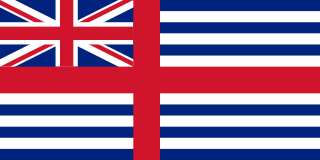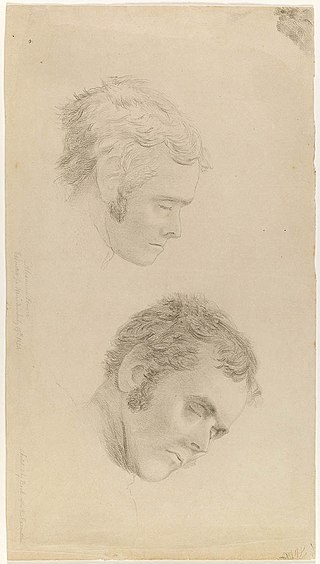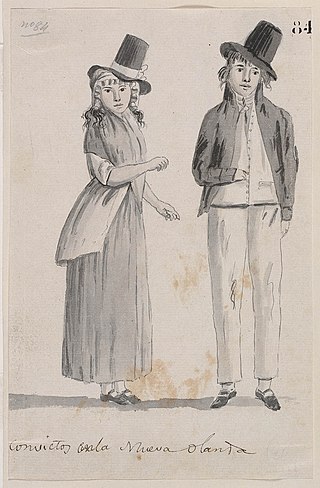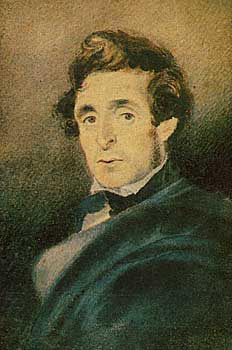
Van Diemen's Land was the colonial name of the island of Tasmania used by the British during the European exploration and colonisation of Australia in the 19th century. The island was previously discovered and named by the Dutch in 1642. Explorer Abel Tasman discovered the island, working under the sponsorship of Anthony van Diemen, the Governor-General of the Dutch East Indies. The British retained the name when they established a settlement in 1803 before it became a separate colony in 1825. Its penal colonies became notorious destinations for the transportation of convicts due to the harsh environment, isolation and reputation for being inescapable.
The history of Tasmania begins at the end of the Last Glacial Period when it is believed that the island was joined to the Australian mainland. Little is known of the human history of the island until the British colonisation of Tasmania in the 19th century.

Macquarie Harbour is a shallow fjord in the West Coast region of Tasmania, Australia. It is approximately 315 square kilometres (122 sq mi), and has an average depth of 15 metres (49 ft), with deeper places up to 50 metres (160 ft). It is navigable by shallow-draft vessels. The main channel is kept clear by the presence of a rock wall on the outside of the channel's curve. This man-made wall prevents erosion and keeps the channel deep and narrow, rather than allowing the channel to become wide and shallow. A reported Aboriginal name for the harbour is Parralaongatek.

The Macquarie Harbour Penal Station, a former British colonial penal settlement, established on Sarah Island, Macquarie Harbour, in the former colony of Van Diemen's Land, now Tasmania, operated between 1822 and 1833. The settlement housed male convicts, with a small number of women housed on a nearby island. During its 11 years of operation, the penal colony achieved a reputation as one of the harshest penal settlements in the Australian colonies. The former penal station is located on the eight-hectare (twenty-acre) Sarah Island that now operates as a historic site under the direction of the Tasmania Parks and Wildlife Service.
Alexander Maconochie was a Scottish naval officer, geographer and penal reformer.

Alexander Pearce was an Irish convict who was transported to the penal colony in Van Diemen's Land, Australia for seven years for theft. He escaped from prison several times, allegedly becoming a cannibal during one of the escapes. In another escape, with one companion, he allegedly killed him and ate him in pieces. He was eventually captured and was hanged in Hobart for murder, before being dissected.

The West Coast of Tasmania has a significant convict heritage. The use of the west coast as an outpost to house convicts in isolated penal settlements occurred in the eras 1822–33, and 1846–47.

Hells Gates is the name of the mouth of Macquarie Harbour on the West Coast of Tasmania, Australia.

Richard Innes Davey was an Australian actor, director and writer. He was the founder of the Round Earth Company and advocate for the understanding of the Macquarie Harbour Penal Station on Sarah Island on the West Coast of Tasmania.

The Round Earth Company, founded by the late Richard Davey, performs in Strahan, West Coast, Tasmania. Each night the company performs Australia's longest-running play, The Ship That Never Was. During the day the actors work as tour guides on Sarah Island, explaining the history and unique story of this Tasmanian penal settlement.

Between 1788 and 1868 the British penal system transported about 162,000 convicts from Great Britain and Ireland to various penal colonies in Australia.

William Sorell was a soldier and third Lieutenant-Governor of Van Diemen's Land.
The modern history of the Australian city of Hobart in Tasmania dates to its foundation as a British colony in 1804. Prior to British settlement, the area had been occupied definitively for at least 8,000 years, and possibly for as long as 35,000 years, by the semi-nomadic Mouheneener tribe, a sub-group of the Nuenonne, or South-East tribe. The descendants of theses indigenous Tasmanians now refer to themselves as 'Palawa'. Little is known about the region from prehistoric times. As with many other Australia cities, urbanisation has destroyed much of the archaeological evidence of indigenous occupation, although aboriginal middens are often still present in coastal areas.
John Lee Archer was the Civil Engineer and Colonial Architect in Van Diemen's Land, serving from 1827 to 1838. During his tenure, Archer was responsible for all Tasmanian government buildings including those for penal and military purposes.
The Young Lachlan was a schooner that was stolen and wrecked by convicts in 1819. Between 1812 and 1817 as the Henrietta Packet it provided passenger and cargo transport between colonial ports, and was possibly involved in exploration in the present-day Tasmania.

Tasmanian Gothic is a genre of Tasmanian literature that merges traditions of Gothic fiction with the history and natural features of Tasmania, an island state south of the main Australian continent. Tasmanian Gothic has inspired works in other artistic media, including theatre and film.

The Last Confession of Alexander Pearce is a 2008 Australian-Irish film directed by Michael James Rowland starring Irish actors Adrian Dunbar as Philip Conolly and Ciarán McMenamin as bushranger Alexander Pearce and an ensemble Australian cast, including Dan Wyllie, Don Hany and Chris Haywood. The film was shot on location in Tasmania and Sydney between April and May 2008.

William Buelow Gould was a painter born in the United Kingdom and later working in Van Diemen's Land. He was transported to Australia as a convict in 1827, after which he would become one of the most important early artists in the colony, despite never really separating himself from his life of crime.
James Goodwin was a convict escapee and explorer in Van Diemen's Land. In March 1828, he escaped from the notorious Sarah Island prison with fellow convict Thomas Connolly, and the two were the first white men to pass through the Lake St Clair region. Assuming Goodwin was then taken on to Hobart, he is the first white man to have traversed Tasmania from west to east.

The Cyprus mutiny took place on 14 August 1829 in Recherche Bay off the British penal settlement of Van Diemen's Land. Convicts seized the brig Cyprus and sailed her to Canton, China, where they scuttled her and claimed to be castaways from another vessel. On the way, Cyprus visited Japan during the height of the period of severe Japanese restrictions on the entry of foreigners, the first ship from Australia to do so.















